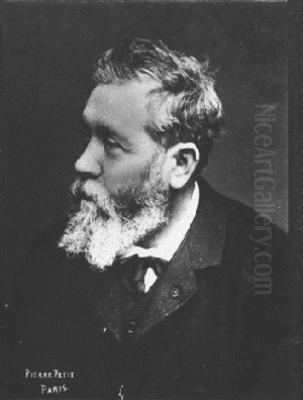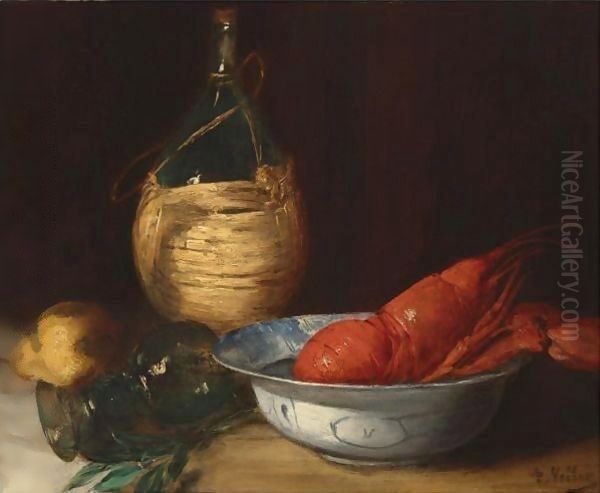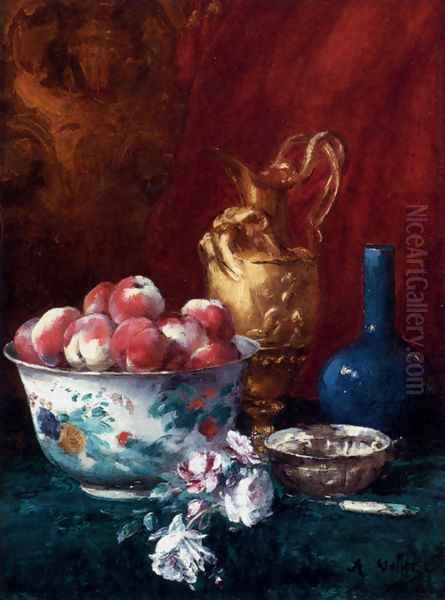
Antoine Vollon stands as a significant figure in the landscape of nineteenth-century French art. Born on April 23, 1833, in Lyon, and passing away in Paris on August 27, 1900, Vollon carved a distinct niche for himself primarily as a master of still life, though his talents extended capably into landscape and figure painting. Operating during a period of immense artistic ferment that saw the flourishing of Realism and the birth of Impressionism, Vollon navigated these currents with a unique sensibility, earning the respect of his peers and the moniker "painter's painter," yet his broader historical recognition has sometimes lagged behind his undeniable skill. This exploration delves into the life, work, influences, and legacy of an artist whose dedication to the tangible world produced works of enduring power and beauty.
Early Life and Artistic Formation in Lyon
Antoine Vollon's origins lie in Lyon, a city with its own rich artistic and industrial heritage. His father was a decorative craftsman, immersing the young Vollon in an environment where manual skill and aesthetic sensibility were intertwined. This early exposure to the applied arts likely shaped his later appreciation for materiality and technique. He received formal training not initially in painting, but in engraving and metalwork, honing his precision and understanding of form. He furthered his studies at the École des Beaux-Arts in Lyon, focusing on printmaking. This foundational training in disciplines demanding meticulous control and an eye for detail would prove invaluable throughout his painting career, underpinning the technical assurance evident even in his most painterly canvases.
The Move to Paris and Key Influences
The year 1859 marked a pivotal moment in Vollon's life as he relocated to Paris, the undisputed center of the European art world. Seeking to establish himself as a painter, he entered the orbit of Théodore Ribot (1823-1891). Ribot, himself a prominent Realist painter known for his dramatic chiaroscuro often reminiscent of Spanish masters like Jusepe de Ribera, became Vollon's mentor. Ribot's influence is discernible in Vollon's early adoption of strong tonal contrasts and a certain dramatic weight in his compositions. Ribot encouraged Vollon to study the masters of the past, particularly those who excelled in depicting the material world with honesty and vigour.

Crucially, Vollon developed a profound admiration for the still-life painters of the Dutch Golden Age. Artists such as Willem Kalf (1619-1693) and Pieter Claesz (1597-1660), with their virtuosic rendering of textures – the gleam of metal, the transparency of glass, the richness of fabrics, and the succulence of food – provided a powerful model. Their ability to elevate everyday objects into subjects of serious artistic contemplation resonated deeply with Vollon's own inclinations.
Furthermore, Vollon looked towards the great French precursor of realistic still life, Jean-Baptiste-Siméon Chardin (1699-1779). Chardin's quiet, contemplative scenes of domestic life and his humble yet exquisitely painted arrangements of kitchen utensils and foodstuffs offered a French lineage for the kind of intimate realism Vollon sought to practice. The influence of these masters provided Vollon with a rich historical foundation upon which to build his own artistic identity.
The Emergence of a Distinctive Style
Synthesizing the lessons learned from Ribot, the Dutch masters, and Chardin, Vollon rapidly developed a style that was recognizably his own. While grounded in Realism's commitment to depicting the observable world accurately, his approach was far from photographic. He embraced a vigorous, often thick application of paint, known as impasto, which gave his surfaces a tangible texture and vitality. His brushwork, while descriptive, retained a visible energy, celebrating the act of painting itself.
His palette, particularly in his still lifes, often revolved around a sophisticated interplay of blacks, greys, whites, and earthy tones, punctuated by strategic accents of richer color, such as deep reds or ochres. Influenced perhaps by Ribot's penchant for dramatic lighting, Vollon frequently employed strong chiaroscuro, using contrasts of light and shadow to model forms, create depth, and imbue his scenes with a sense of presence and sometimes mystery. This combination of robust technique, textural richness, and controlled yet evocative lighting became hallmarks of his mature style.
Mastery of Still Life
It is in the realm of still life that Antoine Vollon achieved his most profound and lasting acclaim. He possessed an extraordinary ability to capture the essence of inanimate objects, transforming humble subjects into compelling visual statements. His studio became a stage for arrangements of kitchenware, gleaming copper pots, earthenware jugs, freshly caught fish, game, fruits, vegetables, and perhaps most famously, mounds of butter. He rendered the varied textures of these objects – the cool smoothness of ceramic, the reflective sheen of metal, the rough skin of a melon, the delicate fins of a fish – with palpable conviction.

His most celebrated work in this genre is arguably Mound of Butter (c. 1875-1885), housed in the National Gallery of Art, Washington D.C. This painting exemplifies his strengths. Using thick, luscious strokes of yellow, ochre, and white paint, Vollon conveys not just the appearance but the very substance and weight of the butter. The way the light catches the ridges and contours carved into the mound, the suggestion of its cool, yielding texture, is a triumph of painterly skill. It transcends mere representation to become an almost sculptural presence on the canvas. The work's reception has been overwhelmingly positive, with critics and curators praising its technical brilliance and its elevation of a mundane subject to high art; indeed, it has been affectionately termed a "treasure" of the Washington collection.
Vollon's still lifes often depict the bounty of the earth or the tools of the kitchen, suggesting themes of sustenance, domesticity, and the simple pleasures of everyday life. Works featuring arrangements of armour or antique objects also appear, showcasing his ability to handle reflective surfaces and intricate details while maintaining a sense of painterly breadth. Through his intense focus and technical prowess, Vollon revitalized the genre of still life in the later 19th century, demonstrating its continued potential for serious artistic expression.
Exploring Landscapes and Seascapes
While best known for still life, Vollon was also a capable and sensitive painter of landscapes and seascapes. He was drawn to the atmospheric conditions and rugged beauty of the Normandy coast, particularly around the port town of Dieppe. Works like View of Dieppe Harbor showcase his ability to capture the bustling activity of a working port, the play of light on water, and the specific character of the coastal environment.
His approach to landscape shared some affinities with the painters of the Barbizon School, such as his friend Charles-François Daubigny (1817-1878), in its commitment to direct observation and its appreciation for rural or coastal scenery. However, Vollon's landscapes often retain the robust brushwork and strong tonal structure characteristic of his still lifes. Compared to the emerging Impressionists like Claude Monet (1840-1926) or Alfred Sisley (1839-1899), who were increasingly preoccupied with capturing the fleeting effects of light and color en plein air, Vollon's landscapes generally feel more solid, structured, and perhaps less focused on optical phenomena, though they certainly demonstrate a keen awareness of atmosphere and light. He shared with Eugène Boudin (1824-1898), another painter associated with the Normandy coast, an interest in capturing expansive skies and maritime scenes.
Figure Painting and Portraits
Vollon also ventured into figure painting and portraiture, although these genres occupy a smaller portion of his oeuvre compared to still life. He depicted peasant figures, fisherwomen, and occasionally portraits of acquaintances. One notable example, Woman Carrying a Basket (Femme du Pollet à Dieppe), drew criticism from the influential modernist painter Édouard Manet (1832-1883). Manet reportedly quipped that the figure was overwhelmed by the still-life elements, remarking something to the effect of, "It's just a basket that walks." While perhaps intended as a witty observation on Vollon's primary strength, the comment highlights the challenges Vollon faced in integrating figures with the same convincing presence he achieved with inanimate objects.
It's possible that such critiques, combined with the overwhelming success and personal affinity he found in still life, led him to concentrate his efforts primarily on that genre later in his career. Nonetheless, his figure paintings demonstrate the same technical solidity and observational honesty found elsewhere in his work, contributing to a fuller picture of his artistic range. He maintained friendships within the artistic and literary circles, including the famed author Alexandre Dumas (likely père, 1802-1870), suggesting a sociable nature despite any professional rivalries.
Navigating the Art World: The Salon and Recognition
In the competitive Parisian art world of the 19th century, the official Salon, organized under the auspices of the Académie des Beaux-Arts, was the primary venue for artists to exhibit their work, gain critical attention, and secure patronage. Vollon navigated this system successfully. He made his Salon debut in 1864 and exhibited regularly thereafter, gradually building his reputation.
His skill was recognized with official accolades. He received medals at the Salon, including a first-class medal reportedly awarded in 1876 (some sources suggest earlier medals as well), signifying significant critical approval within the establishment. This success at the Salon contrasts with the path taken by many Impressionists, who, facing repeated rejection or poor placement by the Salon jury, organized their own independent exhibitions starting in 1874. Vollon remained largely within the official system, achieving considerable renown there.
His standing was further solidified by his election to the prestigious Académie des Beaux-Arts in 1897, a high honor confirming his acceptance by the French artistic establishment. Throughout his career, he earned the deep respect of fellow artists, leading to the complimentary nickname "le peintre des peintres" or "the painter's painter." This term suggests that his technical mastery and profound understanding of the medium were particularly appreciated by those who understood the challenges of painting firsthand, even if his work didn't always align with the most avant-garde trends championed by some critics. He was admired by artists across different stylistic camps, including figures associated with Realism like Gustave Courbet (1819-1877) and even those pushing towards Impressionism like Edgar Degas (1834-1917), who appreciated his technical facility.
Vollon and His Contemporaries
Antoine Vollon's career unfolded amidst a constellation of brilliant artists, and his interactions and comparisons with them help define his position. His relationship with his teacher, Théodore Ribot, was foundational. His friendship with the Barbizon landscape painter Charles-François Daubigny connected him to that important movement focused on naturalism. His complex relationship with Édouard Manet, marked by mutual respect for skill but also critical divergence (as seen in the Woman Carrying a Basket incident), highlights the differing paths within modern French painting.
While contemporary to the Impressionists – including Monet, Degas, Camille Pissarro (1830-1903), and Alfred Sisley – Vollon never fully embraced their core tenets. He shared their interest in everyday subjects and modern life to some extent, but his emphasis remained on substance, texture, and often more controlled, studio-like lighting rather than the Impressionists' focus on capturing the ephemeral effects of natural light and color through broken brushwork. He stands closer to the robust Realism of Gustave Courbet, though perhaps with less overt social commentary, and shares an affinity for still life with contemporaries like Henri Fantin-Latour (1836-1904), although Fantin-Latour's approach was often more delicate and refined. Vollon carved out a space that honored traditional painterly values while engaging with the modern world through his choice of subjects.
Teaching and Influence
As an established and respected artist, Vollon also took on students, passing on his knowledge and approach. Among those documented as having studied with him are Raymond Allègre (1857-1933), Joseph Garibaldi (1863-1941), Henri Michel-Lévy (1844-1914), Théo Mayan (active late 19th/early 20th c.), and Gustave Le Sénéchal de Kerdréoret (1840-1933). Through his teaching, Vollon likely disseminated his emphasis on strong technique, careful observation, and the expressive potential of paint itself. While perhaps not founding a major 'school' in the way some other artists did, his influence can be seen in painters who continued to value solid draftsmanship and rich painterly surfaces within the realist tradition. His work served as a benchmark for technical excellence in still life for subsequent generations.
Later Years and Legacy
Antoine Vollon continued to paint productively throughout his later years, remaining a respected figure in the Parisian art scene until his death in 1900. However, in the decades immediately following his death, his reputation experienced a period of relative obscurity. The rise of Post-Impressionism, Fauvism, Cubism, and other revolutionary movements shifted critical and public attention towards more radical artistic innovations. Artists like Vollon, who had achieved success within a more traditional framework, were sometimes overshadowed.
It was not until the later twentieth century that a significant reassessment of nineteenth-century art began, leading to a renewed appreciation for artists operating outside the main narrative of modernist progression. Vollon's work began to attract more scholarly attention and market interest. Exhibitions and publications helped re-establish his importance. As noted by the PaceWildenstein gallery in a 2004 exhibition context, his exact place within the hierarchy of French painting history might still be considered somewhat under-evaluated by some, particularly within France itself.
Despite this, his international reputation, particularly in the United States where major museums hold significant examples of his work (like the NGA's Mound of Butter), is strong. His legacy rests on his exceptional skill as a painter, particularly his revitalization of the still-life genre. He demonstrated that realism, infused with painterly bravura and a keen sensitivity to the material world, remained a vital and expressive force even amidst the dramatic changes sweeping the art world.
Conclusion
Antoine Vollon remains a compelling figure in French art history. A master technician with an innate feel for the substance and texture of the world, he elevated the genre of still life to remarkable heights in the later nineteenth century. His robust brushwork, sophisticated use of light and shadow, and ability to find beauty in the everyday earned him the admiration of his fellow artists and significant success within the official Salon system. While deeply influenced by the Dutch masters and Chardin, and mentored by Ribot, he forged a distinctive style that bridged traditional craftsmanship with a modern realist sensibility. Though his fame waned for a time after his death, his work endures, celebrated for its technical brilliance, its honesty of observation, and its sheer painterly power. As the "painter's painter," Antoine Vollon's contribution lies not only in his beautiful canvases but also in his unwavering dedication to the art of painting itself.